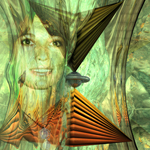From a friend’s car repair shop in 1965, where he got the idea of how to use plaster and paints, to digital techniques in 2012.
Throughout this period of time Minguzzi’s technique changes significantly and his paintings evolve accordingly.
Four important phases can be identified:
1964-1972: His works are characterised by several layers of colour (car paint) on masonite (chipboard) sheets, which are then polished to enhance lines and tones. This is also the period of multi-material applications on canvas. “Spaces emerged from vast surfaces covered with intense polychromic tones. These spaces seem abstract and undefined in themselves but become defined and are rendered in dymamic by a peremptory geometrical rationality” (1)
Very diverse materials are used: mixtures of coloured soils, shiny or coloured metal strips, mosaic tiles and plexiglas objects of varying shapes.
“And so the composition is reflected in the materials used, eventually identifying with the materials themselves. The painting, its internal aesthetic organisation realisation, depends on the resulting effect and on its polychromatic, spatial and geometric connections, which are based on the dialectics of signs: the matrix becomes essential and takes shape.”
(1)
1972-1974 Canvas is replaced by a plexiglas sheet through which the painting can be seen and onto which geometrical elements, also in plexiglas, are applied, resulting in a perfect fusion of colour and material.
“The chromatic and material elements mix and merge creating elegant space-time effects”.
(2)
1975 Minguzzi’s style evolves into optical movement which is interpreted using a totally original technique. The dynamism is conveyed by the combination of horizontal and vertical modules of different colours, which follow an undulating pattern.
The transparency of the Plexiglas sheet confers light and enhances the optical effect.
2009-2018
Minguzzi decides to reinterpret its work of the "optical genre" with the aid of digital technique that allows to obtain new forms of expression. All the works are made starting from one or more previously painted subjects, thus obtaining totally innovative representations.
This technique has also become the tool for the representation of a new form of expression: the contamination of photographic images with the pictorial works manipulated digitally.
To obtain better results, he decided to set up what could be called the heir of the ancient Renaissance workshops, together with Stefano Pelloni and Mattia Franchi, a structure called "Multiverse Studio" where creative energies are developed towards continuous and constant artistic research.
1) Gualtiero De Santi 1972
2) Guido Laghi 1973












